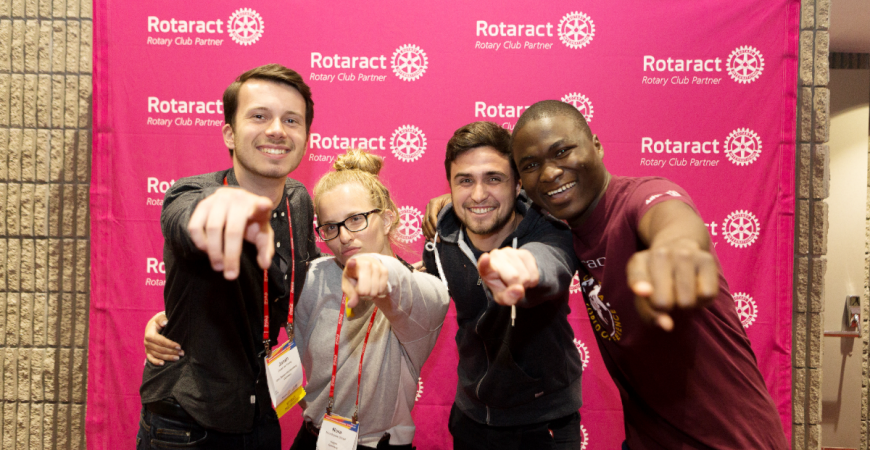The ongoing evolution of Rotaract is redefining its place within Rotary. “It’s a new era,” says one enthusiastic Rotaractor
by Vanessa Glavinskas
Editor’s Note: This story originally appeared in the May issue of The Rotarian magazine. Since publishing, Interota has been postponed to 2021. Learn more about next year’s Interota.
At midnight on 30 June, hundreds of Rotaractors will ring in the new Rotary year together. They’ll also be celebrating Rotaract’s ongoing evolution, including the expansion of Rotary membership to include Rotaract clubs.
“It’s really exciting,” says Ignacio González, a member of the Rotaract Club of Oriente de Talca in Chile. Until recently, Rotaractors have been considered Rotary program participants. “Now,” says González, who serves on the Elevate Rotaract Task Force, “we are a part of Rotary. It’s a new era for Rotaract.”
Rotaract’s elevated status within the organization was approved by Rotary’s Council on Legislation in 2019 as part of an ongoing effort to make Rotary more appealing and welcoming to young professionals. “We keep telling Rotarians to find a way to bring in young people, when we have them already and we seem to forget them,” says 2018-19 Rotary President Barry Rassin. It was Rassin who formally proposed expanding the definition of Rotary membership to include both Rotary and Rotaract.
Rotary programs include: Interact, Rotary Youth Exchange, Rotary Youth Leadership Awards, New Generations Service Exchange, Rotary Peace Fellowships, and Rotary Community Corps.
After the Council approved revising the RI Constitution and Bylaws to include Rotaract as a membership type, the Elevate Rotaract Task Force — made up of both Rotaractors and Rotarians — was formed and began surveying members to come up with policy recommendations for the transition. “We’re hearing from Rotaractors all over the world,” says David D. Stovall, RI treasurer and chair of the task force.
On the advice of the task force, the RI Board of Directors in October approved several changes to Rotaract — the most notable being the removal of Rotaract’s upper age limit. As of 1 July, members of Rotaract will no longer be required to leave their club when they turn 31. Clubs will still be able to set their own age limit, if they wish.
Elyse Lin, a member of the Rotaract Club of Taipei Tin Harbour in Taiwan who is also on the task force, says the age limit was an obstacle for Rotaract members who wanted to stay involved with Rotary but either didn’t feel ready for a traditional Rotary club or found the expense of joining one out of reach. “Once those members leave, it’s very hard to get them back into the Rotary family,” Lin notes. Although some Rotaract alumni continue to participate in Rotaract events, she says, they often no longer feel like a true part of the organization. With the rules change, she predicts some recent alumni will rejoin Rotaract.
Rotaract clubs will be able to take advantage of products and services such as new leadership development resources from Toastmasters International, updated online goal-setting tools, and an improved online club administration experience.
Other changes: New Rotaract clubs won’t have to rely on a Rotary club to sponsor them; they can now sponsor themselves or choose another Rotaract club as their sponsor. And Rotaractors are now eligible — and encouraged — to serve alongside Rotarians on district and RI committees. “Elevate Rotaract is really a call for a closer partnership between Rotary and Rotaract,” explains Clement Chinaza Owuamalam, a member of the Rotaract Club of Apo, Nigeria, who serves on the task force.
Rotaract clubs will also gain more support from Rotary International, including access to administrative tools on My Rotary and the option to subscribe to the digital edition of The Rotarian magazine. As the transition from Rotary program to membership type gets underway, the Trustees of The Rotary Foundation also plan to discuss whether Rotaract clubs should be eligible to apply for Foundation grants.
One thing Rotaractors are looking for, says Ronald S. Kawaddwa, a member of the Rotary Club of Kasangati, Uganda, is more professional development opportunities. To meet this demand, a leadership training program Rotary is rolling out with Toastmasters will also be available to Rotaract members. “At age 30, you are launching your professional career,” says Kawaddwa, who is on the task force. “If Rotaract provides a better package in terms of professional development, that adds value.”
Rotary has a new alliance with Toastmasters International, and Rotary’s online learning center will host a curriculum created by Toastmasters that will help members improve their leadership and communication skills. To learn more, visit rotary.org/toastmasters.
In 2022, annual dues of $5 per person for university-based Rotaract clubs and $8 for community-based clubs will be introduced to cover the cost of additional support for Rotaract clubs. RI will work to develop and promote alternative funding sources to help Rotaractors pay dues, including fundraising opportunities.
Kawaddwa says that shifting the public perception of Rotary is particularly important to attracting more young people in his region. “On the African continent, most of the population is below the age of 30,” he says. “If Rotary remained the way it was, it would soon become irrelevant.”
Letting Rotaract members stay in their clubs longer gives them more time to learn about Rotary, Kawaddwa adds. “We hope that these changes will produce stronger Rotarians, members who have served longer and gotten more experience and mentorship while in Rotaract.”
For more information on the changes made to Rotaract and freqently asked questions click here.

